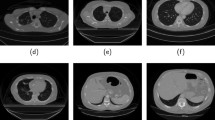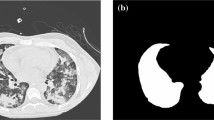Abstract
Lung segmentation is a key step of thoracic computed tomography (CT) image processing, and it plays an important role in computer-aided pulmonary disease diagnostics. However, the presence of image noises, pathologies, vessels, individual anatomical varieties, and so on makes lung segmentation a complex task. In this paper, we present a fully automatic algorithm for segmenting lungs from thoracic CT images accurately. An input image is first spilt into a set of non-overlapping fixed-sized image patches, and a deep convolutional neural network model is constructed to extract initial lung regions by classifying image patches. Superpixel segmentation is then performed on the preprocessed thoracic CT image, and the lung contours are locally refined according to corresponding superpixel contours with our adjacent point statistics method. Segmented lung contours are further globally refined by an edge direction tracing technique for the inclusion of juxta-pleural lesions. Our algorithm is tested on a group of thoracic CT scans with interstitial lung diseases. Experiments show that our algorithm creates an average Dice similarity coefficient of 97.95% and Jaccard’s similarity index of 94.48%, with 2.8% average over-segmentation rate and 3.3% under-segmentation rate compared with manually segmented results. Meanwhile, it shows better performance compared with several feature-based machine learning methods and current methods on lung segmentation.

















Similar content being viewed by others
References
Zhou S, Cheng Y, Tamura S: Automated lung segmentation and smoothing techniques for inclusion of juxtapleural nodules and pulmonary vessels on chest CT images. Biomed Signal Process Control 13: 62–70, 2014
Armato III S, Sensakovic W: Automated lung segmentation for thoracic CT: impact on computer-aided diagnosis1. Acad Radiol 11 (9): 1011–1021, 2004
Sluimer I, Prokop M, Van Ginneken B: Toward automated segmentation of the pathological lung in CT. IEEE Trans Medical Imag 24 (8): 1025–1038, 2005
Hu Z, Tang J, Wang Z, et al: Deep learning for image-based cancer detection and diagnosis- a survey. Pattern Recognit 83: 134–149, 2018
Litjens G, Kooi T, Bejnordi B, et al: A survey on deep learning in medical image analysis. Med Image Anal 42: 60–88, 2017
Sahu S, Agrawal P, Londhe N, et al: A new hybrid approach using fuzzy clustering and morphological operations for lung segmentation in thoracic ct images. Biomed Pharmacol J 10 (4): 1949–1961, 2017
Gomathi M, Thangaraj P: A new approach to lung image segmentation using fuzzy possibilistic c-means algorithm. Int J Comput Sci Inf Secur 7 (3): 14–24, 2010
Santos A, de Carvalho Filho A, Silva A, et al: Automatic detection of small lung nodules in 3D CT data using Gaussian mixture models, Tsallis entropy and SVM. Eng Appl Artif Intell 36: 27–39, 2014
Arimura H, Katsuragawa S, Suzuki K, et al: Computerized scheme for automated detection of lung nodules in low-dose computed tomography images for lung cancer screening. Acad Radiol 11 (6): 617–629, 2004
Mansoor A, Bagci U, Xu Z, et al: A generic approach to pathological lung segmentation. IEEE Trans Med Imaging 33 (12): 2293–2310, 2014
Alin Mercybha P, Brinda T: Intelligent pathological lung segmentation using random forest machine learning. Int J Innov Res Comput Commun Eng 3 (3): 21–26, 2015
Dincer E, Duru N: Automatic lung segmentation by using histogram based k-means algorithm.. In: Proceedings of International Conference on Electric Electronics, Computer Science, Biomedical Engineerings Meeting, 2016, pp 1–4
Liu C, Zhao R, Pang M: A fully automatic segmentation algorithm for CT lung images based on random forest. Med Phys 47 (2): 518–529, 2020
Shen S, Bui A, Cong J, et al: An automated lung segmentation approach using bidirectional chain codes to improve nodule detection accuracy. Comput Biol Med 57: 139–149, 2015
Liu C, Zhao R, Pang M: Lung segmentation based on random forest and multi-scale edge detection. IET Image Process 13 (10): 1745–1754, 2019
Jalal D, Ganesan R, Merline A: Fuzzy-c-means clustering based segmentation and CNN-classification for accurate segmentation of lung nodules. Asian Pac J Cancer Prev Apjcp 18 (7): 1869–1874, 2017
Park B, Park H, Lee S, et al: Lung segmentation on HRCT and volumetric CT for diffuse interstitial lung disease using deep convolutional neural networks. J Digital Imaging 32 (6): 1019–1026, 2019
Islam J, Zhang Y (2018) Towards robust lung segmentation in chest radiographs with deep learning. arXiv:1811.12638, 1–5
Xu M, Qi S, Yue Y, et al: Segmentation of lung parenchyma in CT images using CNN trained with the clustering algorithm generated dataset. Biomed Eng Online 18 (1): 1–21, 2019
Tajbakhsh N, Suzuki K: Comparing two classes of end-to-end machine-learning models in lung nodule detection and classification: MTANNS vs. CNNS. Pattern Recognit 63: 476–486, 2017
LeCun Y, Bottou L, Bengio Y, et al: Gradient-based learning applied to document recognition. Proc IEEE 86 (11): 2278–2324, 1998
Lai Z, Deng H: Medical image classification based on deep features extracted by deep model and statistic feature fusion with multilayer perceptron. Comput Intel Neurosc 28: 1–13, 2018
Palm R (2014) Deeplearntoolbox, a matlab toolbox for deep learning. [Online]. Dispon⋅⋅avel em: https://github.com/rasmusbergpalm/DeepLearnToolbox
Achanta R, Shaji A, Smith K, et al: SLIC superpixels compared to state-of-the-art superpixel methods. IEEE Trans Pattern Anal Mach Intell 34 (11): 2274–2282, 2012
Vincent L: Morphological grayscale reconstruction in image analysis: Applications and e cient algorithms. IEEE Trans Image Process 2 (2): 176–201, 1993
Bai J, Feng X: Fractional-order anisotropic diffusion for image denoising. IEEE Trans Image Process 16 (10): 2492–2502, 2007
Depeursinge A, Vargas A, Platon A, et al: Building a reference multimedia database for interstitial lung diseases. Comput Med Imag Grap 36 (3): 227–238, 2012
de Siqueira F, Schwartz W, Pedrini H: Multi-scale gray level co-occurrence matrices for texture description. Neurocomputing 120: 336–345, 2013
Funding
The work in this paper was supported by grants from the National Natural Science Foundation of China (Grant Nos. 41631175, 61702068), the Key Project of Ministry of Education for the 13th 5-years Plan of National Education Science of China (Grant No. DCA170302), the Social Science Foundation of Jiangsu Province of China (Grant No. 15TQB005), the Priority Academic Program Development of Jiangsu Higher Education Institutions (Grant No. 1643320H111) and the Postgraduate Research & Practice Innovation Program of Jiangsu Province (Grand No. KYCX19_0733).
Author information
Authors and Affiliations
Corresponding author
Ethics declarations
Conflict of Interest
The authors declare that they have no conflict of interest.
Additional information
Publisher’s Note
Springer Nature remains neutral with regard to jurisdictional claims in published maps and institutional affiliations.
Rights and permissions
About this article
Cite this article
Liu, C., Pang, M. Extracting Lungs from CT Images via Deep Convolutional Neural Network Based Segmentation and Two-Pass Contour Refinement. J Digit Imaging 33, 1465–1478 (2020). https://doi.org/10.1007/s10278-020-00388-0
Received:
Revised:
Accepted:
Published:
Issue Date:
DOI: https://doi.org/10.1007/s10278-020-00388-0




